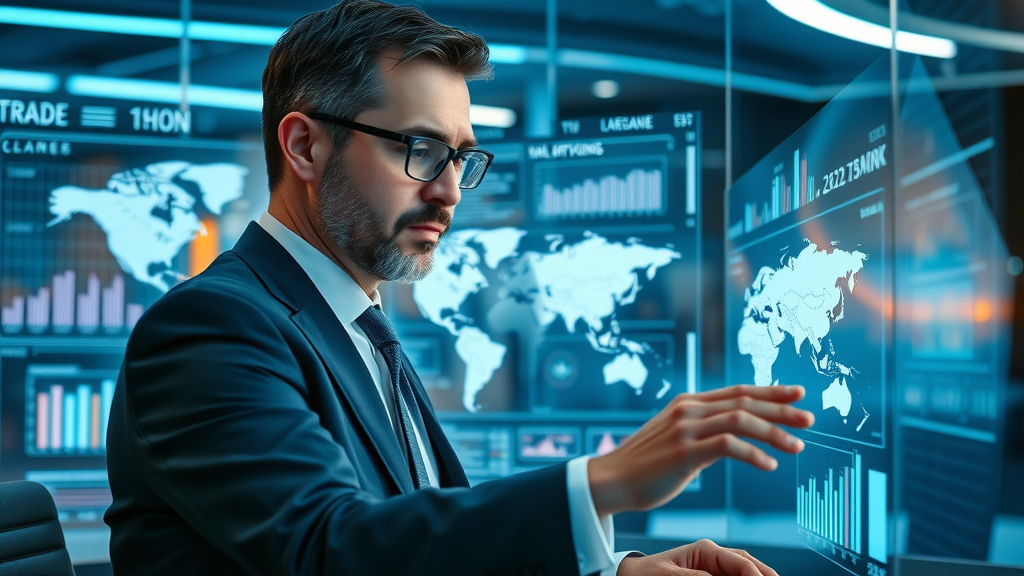Did you know that nearly 64% of manufacturers plan to move production closer to their customers this year? In a world rocked by supply chain disruptions, this dramatic shift toward nearshoring for manufacturers isn’t just another fleeting trend—it’s reshaping how global businesses operate and thrive. Manufacturers from every sector are realizing the strategic advantages of bringing operations closer to home, accelerating supply chain resilience, and unlocking new growth opportunities in North America and beyond. This in-depth editorial breaks down exactly why nearshoring is booming—and why the smartest businesses are acting now.A Startling Shift: The Rapid Rise of Nearshoring for ManufacturersThe manufacturing landscape is undergoing a strategic shift as companies seek to reduce risk, cut transportation costs, and improve supply chain resilience. In recent years, businesses have grappled with global supply chain disruptions that exposed vulnerabilities—and prompted urgent change. This surge of nearshoring and reshoring is compelling manufacturers to reexamine every aspect of their business operation. By moving operations closer to home, companies are not only shortening lead times and transit times, but also gaining increased control over quality and boosting responsiveness to market demands.For many manufacturers, particularly those in the United States and North America, nearshoring offers a powerful answer to recurring challenges. Complex global supply chains, especially those dependent on East Asia, are being replaced by regional networks that emphasize agility and risk mitigation. Regulatory shifts, tariff changes, and increased consumer expectations further reinforce this momentum. With manufacturers looking to improve customer experience and reduce costs, the nearshoring trend now represents not just a change in geography but a total transformation in supply chain strategy and business operation.A Data-Driven Look: Nearshoring and Supply Chain TrendsBacking this trend are impressive numbers: “Nearly 64% of manufacturers surveyed in 2023 expressed intentions to move production closer to end consumers, catalyzing a new era in supply chain strategy.” This statistic from recent industry reports signals the overwhelming move toward regional manufacturing hubs. Companies are leveraging local labor markets and proximity to achieve faster lead times and mitigate risks. The shift reflects an understanding that traditional global supply chain models—optimized primarily for labor cost—can compromise responsiveness, increase exposure to disruptions, and raise overall risk. In today’s volatile global environment, the value of rapid adaptation and chain resilience outweighs a narrow focus on low labor cost alone.“Nearly 64% of manufacturers surveyed in 2023 expressed intentions to move production closer to end consumers, catalyzing a new era in supply chain strategy.” — Industry ReportAs manufacturers weigh the benefits of nearshoring, it's important to recognize how evolving trade policies and tariff strategies can further influence these decisions. For a deeper dive into how recent tariff approaches are shaping the manufacturing landscape, explore the analysis in Understanding Trump's Tariff Strategy: What It Means For You.What You’ll Learn in This ArticleThe definition and core drivers behind nearshoring for manufacturersHow nearshoring for manufacturers transforms supply chains and supply chain resilienceComparisons between nearshoring, reshoring, and offshoring strategiesKey sectors and industries leading the nearshoring trendThe role of labor costs, time zones, and lead times in nearshoring for manufacturersActionable insights and expert opinions on future trendsUnderstanding Nearshoring for Manufacturers: Definitions and Core ConceptsAt its foundation, nearshoring for manufacturers refers to relocating production facilities closer to the primary markets they serve. This approach is fundamentally different from traditional offshoring, which prioritized low labor costs in distant regions like East Asia. Today, businesses are prioritizing supply chain resilience, flexibility, and faster delivery—advantages that are more easily achieved when manufacturing operations are closer to home. The growing emphasis on time zone alignment and reduced transportation costs is causing firms of every size to rethink their approach to global supply.One of the core benefits of nearshoring is its direct impact on supply chains. With production moved closer to major consumer bases in regions such as North America, companies can swiftly adjust to market fluctuations, maintain higher quality control, and reduce risk of disruptions due to geopolitical issues or long transit times. These factors are central to modern supply chain strategies and have become a competitive differentiator for manufacturers seeking to lead in their markets.Nearshoring and Reshoring: What’s the Difference?The terms nearshoring and reshoring are often used interchangeably, but they have distinct meanings. Nearshoring moves production to a nearby country—for example, a U.S. company choosing Mexico or Canada. Reshoring, by contrast, means bringing manufacturing operations all the way back to the company’s home country, such as moving production from East Asia to the United States. Both strategies aim to increase supply chain resilience and reduce lead times, yet nearshoring can offer a balance between lower labor costs and geographic proximity, giving manufacturers a compelling blend of cost efficiency and operational control.For companies wrestling with unpredictable global supply disruptions and seeking to optimize supply chain strategy, understanding this distinction has practical implications. While onshoring may provide the highest control, nearshoring balances fast market response, lower transportation costs, and reasonable labor costs—critical factors for manufacturers weighing the best way forward for their business operation.How Nearshoring for Manufacturers Alters the Supply Chain LandscapeNearshoring fundamentally changes the flow of goods, information, and supply chain strategy. By shifting production closer to consumer markets, manufacturers shorten lead times and minimize transit times, leading to a more nimble and flexible supply network. This proximity also improves responsiveness to demand shifts, reduces inventory holding costs, and can streamline collaboration across business units.Moreover, nearshoring for manufacturers strengthens quality control by enabling closer supervision of manufacturing operations and supply chain partners. With reduced transportation costs and fewer language, cultural, and time zone barriers, communication improves, leading to better outcomes and higher rates of problem resolution. In volatile markets, these advantages add up to a more resilient and reliable supply chain, ultimately supporting continued growth and stability for the business.The Growing Demand for Supply Chain ResilienceSupply chain resilience has shifted from a nice-to-have to a necessity. The past few years have illustrated how even the smallest disruptions can ripple through a global supply chain, creating shortages, delays, and missed opportunities. By nearshoring manufacturing operations, companies can ensure faster recovery from shocks, minimize dependency on distant suppliers, and respond agilely to regulatory shifts or changing consumer taste. This structural adaptation helps organizations sustain business continuity and remain competitive in a rapidly changing economic environment.Industry leaders now prudently measure the cost of disruptions—not just the visible transportation costs, but also lost sales, damage to reputation, and missed market opportunities. As such, supply chain resilience is central to corporate strategy. Moving manufacturing operations closer to North America or other major markets is the logical response, making nearshoring for manufacturers both a timely opportunity and a long-term imperative.Supply Chain Evolution: Why Manufacturers are Moving CloserThe COVID-19 pandemic and ongoing geopolitical shifts laid bare the vulnerabilities in extended global supply chains. Manufacturers faced serious supply chain disruptions stemming from bottlenecks at ports, rising freight prices, and labor shortages abroad. North American manufacturers, in particular, dealt with the repercussions of relying on far-flung operations in East Asia, often encountering delays that impacted customer satisfaction and revenue streams. As demand for supply chain resilience intensified, many companies began to seriously consider the benefits of bringing manufacturing operations closer to home.By nearshoring, manufacturers are able to mitigate transportation costs, reduce transit times, and enhance their ability to react to sudden demand changes. This strategic repositioning enables more efficient coordination among stakeholders, from suppliers to distributors, and helps manage business risks. For companies seeking to optimize their business operation in the face of turbulence, this shift is both a prudent cost-saving measure and a means to ensure continuity in an unpredictable world.Global Supply Chain Disruptions and their Impact on ManufacturersMajor disruptions—ranging from pandemic-related closures to transportation bottlenecks and geopolitical conflicts—have forced manufacturers to reevaluate their dependence on fragile, overseas supply networks. Prolonged delays, erratic lead times, and unpredictable shipping costs fueled frustration and financial risk, particularly for companies operating in or sourcing from East Asia. The cumulative impact of these challenges led many organizations to realize that moving closer to home greatly improves supply chain reliability and control over business operation.Today’s global supply chain environment demands greater agility. By realigning manufacturing operations to be nearer to consumer markets, businesses can actively reduce risk, improve quality, and keep operations running smoothly—even in the face of inevitable chain disruptions. For North American manufacturers, the result is a more robust, adaptable, and competitive supply chain, designed to withstand future shocks.Case Study: Supply Chain Resilience in North AmericaConsider the North American automotive sector, which has made significant strides in nearshoring and reshoring production. When pandemic closures hamstrung factories in Asia, automakers with regional supply networks in Mexico and the U.S. rebounded faster than those dependent on long-haul shipments. This resilience was attributed to shorter transit times, simplified logistics, and the ability to substitute suppliers more easily—proving the value of a localized supply chain network.Beyond automotive, sectors such as electronics and medical devices have followed suit. By reducing transportation costs and minimizing reliance on overseas factories, these companies saw not only improved risk management but also enhanced flexibility to implement quality control measures and rapidly launch new products. Their experience illustrates how nearshoring for manufacturers isn’t just about cost savings—it’s about positioning for future growth and market leadership.Comparison of Offshore, Reshoring, and Nearshoring for ManufacturersStrategyLabor CostLead TimeRiskQuality ControlSupply Chain ResilienceOffshoring (e.g., East Asia)LowestLongestHighLimitedWeakReshoring (Home Country)HighestShortestLowestExcellentStrongNearshoring (e.g., North America region)ModerateShortModerateGoodImprovedNearshoring for Manufacturers: Key Drivers and Emerging TrendsSeveral critical factors are driving the adoption of nearshoring for manufacturers. The relentless pursuit of cost efficiency—previously centered on low wages in East Asia—is now balancing with an urgent need for reliability, reduced transit and lead times, and lower overall transportation costs. What’s more, nearshoring enables better time zone overlap for partners, making communication and collaboration much smoother. Manufacturers today value closer relationships with their suppliers, as these foster innovation and support rapid adaptation within shifting markets.Emerging trends include the integration of advanced technology, such as automation and real-time data tracking, which strengthen regional manufacturing networks. The rise of environmental, social, and governance (ESG) practices further fuels this momentum—localizing the supply chain can help reduce environmental impact and support social responsibility goals. Ultimately, nearshoring reflects a pragmatic response to a world where speed, flexibility, and resilience now outshine outdated single-focus labor cost strategies.Labor Costs, Time Zones, and Lead Times: Why They MatterLabor cost has long driven manufacturing offshore, but manufacturers now recognize that shortened lead times and aligned time zones can be worth the higher price. For many products, time-to-market is critical; even the lowest cost production loses its value if delays erode customer trust and kill demand. By nearshoring to North America, companies can reduce lead time, boost synchronization across the supply chain, and respond to orders with agility.Operations conducted within similar time zones facilitate real-time communication and coordination. Mistakes are corrected faster, product issues addressed promptly, and design changes implemented more efficiently. When manufacturers balance moderate labor costs against supply chain speed and real-time oversight, the case for nearshoring becomes not only compelling but self-evident.How Nearshoring Enhances Supply Chain Resilience and EfficiencyAt the core of nearshoring’s appeal is its power to improve supply chain resilience and operational efficiency. By building a regional supply network, manufacturers can quickly reroute shipments, contract with backup suppliers, or switch production lines in response to disruptions. This flexibility is especially crucial during uncertain times, as companies with nearshored operations report less downtime, lower inventory write-offs, and fewer stockouts than those relying on global supply routes.Efficiency also comes from more predictable and manageable transportation costs, decreased customs complexity, and streamlined regulatory compliance. Together, these benefits optimize supply chain performance—helping manufacturers achieve reliable, cost-effective, and high-quality business operation.The Nearshoring Trend: United States, North America, and BeyondThe nearshoring trend is most prominent in the United States and North America, yet companies in Europe and Asia-Pacific are also adopting this approach. In Mexico and Canada, manufacturing investment has surged, driven by new trade deals, access to skilled labor, and the advantages of geographic proximity. Major brands have announced expanded presence in these regions, leveraging government incentives and modern infrastructure to support advanced manufacturing operation.This shift signals a broader reconfiguration of supply chains across the globe, with businesses rebalancing their networks between efficiency and resilience. As trade tensions, tariffs, and geopolitical risks continue, nearshoring is poised to play an even greater role in shaping the future of manufacturing—and in strengthening economic competitiveness for the regions that embrace it.Industries Benefiting from Nearshoring for ManufacturersCertain sectors have moved fastest to adopt nearshoring for manufacturers, leveraging its advantages for their unique business operation and supply chain requirements. These industries benefit from both shorter lead times and reduced risk of chain disruptions, while often enjoying lower transportation costs due to proximity. Companies in North America stand out for harmonizing production with rapidly shifting consumer demands in local and regional markets.The nearshoring trend, bolstered by breakthrough advances in automation and smart logistics, is transforming how these businesses produce, distribute, and refine their products. Business leaders and industry analysts alike recognize that proximity is now central to long-term supply chain strategy and resilience.Sectors Most Engaged in Nearshoring and ReshoringAutomotiveElectronicsTextiles and ApparelMedical DevicesConsumer GoodsEach of these sectors has unique challenges—from just-in-time inventory needs (automotive) to regulatory compliance (medical devices)—making supply chain clarity and rapid product delivery essential. These industries view nearshoring and reshoring as more than logistical adjustments; they are transformative tools for business growth and innovation.As North America becomes the new hub for these industries, their commitment to building regionalized supply chains sets an example for others. Success stories abound, showing greater market resilience, improved cost efficiency, and bolder innovation where nearshoring is embraced.Lessons Learned: Case Examples from North American MarketsLeading North American companies offer practical case studies in nearshoring success. In the electronics sector, U.S. manufacturers that shifted assembly lines to Mexico saw a 30% reduction in lead times and dramatically fewer shipment delays. The consumer goods industry, meanwhile, accelerated new product launches by maintaining close proximity to design, production, and key distribution channels across the continent.Importantly, these firms demonstrated that adapting to local market needs and building close supplier partnerships fostered agility—and opened new revenue streams. Their focus on sustainability (through reduced environmental impact and more ethical labor practices) further distinguishes them, making nearshoring for manufacturers a win-win for profitability and social responsibility.Expert Viewpoint: Opportunities and Risks in Nearshoring for ManufacturersThe growth of nearshoring offers both tremendous potential and real challenges. Industry experts underline that moving production closer to home reduces exposure to global supply chain shocks, and provides a strategic lever for business operation continuity. However, the transition is not without pitfalls—companies must manage organizational complexity, reestablish supply partnerships, and sometimes accept higher direct labor costs or regulatory hurdles. As a result, careful planning and agile management are essential.“Nearshoring is no longer just a cost play—it’s a strategic imperative for supply chain resilience and business continuity.” — Supply Chain AnalystSuccessful nearshoring strategies blend technological investment, strong leadership, and rigorous market analysis. Executives agree: companies that invest in data analytics, supplier relationship management, and robust compliance frameworks are best-positioned to reap the rewards of regional manufacturing networks.Supply Chain Disruptions: Managing Risk in a Volatile Global MarketRecent global events have reinforced the lesson that chain disruptions are now the norm, not the exception. Manufacturers relying on a single region, such as East Asia, face heightened exposure to logistical bottlenecks, fluctuating transportation costs, and political instability. Conversely, those with nearshored or multi-regional networks experience faster recovery, lower business risks, and an improved ability to adapt to regulatory changes.Risk diversification is central to any sound supply chain strategy. When manufacturers build resilience through nearshoring, they set a foundation for business operation that can endure—and thrive—whatever the future brings.How Manufacturers Can Prepare for Supply Chain ShiftsPreparation for supply chain shifts requires scenario planning, investment in digital tools, and deep collaboration across the entire extended supply chain. Manufacturers should assess vulnerabilities in their current networks, invest in real-time data tracking and automation, and establish clear contingency protocols. Building trusted relationships with local and regional suppliers becomes a critical enabler of day-to-day agility and long-term growth. Preparing organizational culture and systems for rapid adaptation is equally important—companies must foster a mindset that welcomes change and values resilience as much as efficiency.How Nearshoring for Manufacturers Fuels North American GrowthThe move toward nearshoring isn’t just a supply chain tactic—it’s an economic growth engine. By driving investment into North American facilities, nearshoring supports job creation, encourages technological innovation, and strengthens local economies. Communities in the United States, Mexico, and Canada see tangible benefits, from new infrastructure to expanded training programs and partnerships between industry and education.This ripple effect promotes sustainable growth, empowering workers and communities while elevating the region’s global competitiveness. Manufacturers that embrace nearshoring are not only future-proofing their businesses, but also supporting the broader economic health of North America.Economic Benefits: Job Creation, Innovation, and Local InvestmentNearshoring for manufacturers creates thousands of new jobs in skilled trades, engineering, logistics, and support services. By tapping into local talent pools, companies discover innovative solutions, streamline business operations, and develop best-in-class production capabilities. Investment in automation, robotics, and digital infrastructure further accelerates this cycle, giving North American manufacturing a new edge in quality, efficiency, and sustainability. These advances multiply as supplier networks expand and more companies choose to operate closer to home.Local investment doesn’t just benefit large corporations; it lifts entire communities. Supplier diversity initiatives, workforce retraining, and public-private partnerships extend the advantages of nearshoring beyond the factory floor—delivering real impact to people, neighborhoods, and regional economies across North America.Policy, Tariffs, and Regulatory Trends Impacting NearshoringTrade policy, tariff structures, and new government incentives play a pivotal role in the momentum behind nearshoring for manufacturers. Recent agreements like the USMCA have facilitated cross-border commerce, while shifting tariff landscapes make producing in North America more compelling than ever. Regulatory clarity and streamlined customs procedures further encourage investment—and penalize the complexity inherent in old-school, far-flung supply chains.“The recent surge in nearshoring for manufacturers has made North America a preferred destination for global production relocation.” — Trade Policy ExpertFor businesses evaluating next steps, staying abreast of policy trends, tax incentives, and compliance challenges is critical. Proactive engagement with policymakers, trade organizations, and local governments can unlock competitive advantages and smooth the path to successful nearshoring strategies.Nearshoring for Manufacturers: Potential Pitfalls and How to Avoid ThemNo transition is free from risk. As manufacturers move operations closer to home, they face new challenges in complexity management, regulatory compliance, and supplier selection. Initial costs may rise, and workforce retraining is often needed. Yet, with careful planning, most obstacles can be met and managed for long-term benefit. Companies that misjudge the scope, underestimate cultural differences, or fail to modernize their technology stack expose themselves to fresh vulnerabilities—reminding us that local isn’t always synonymous with simple.To ensure success, manufacturers should prioritize organizational adaptability, openly communicate throughout the business operation, and build scalable systems capable of supporting growth and innovation over time. A robust, forward-thinking supply chain strategy is the best way to sustain the resilience and efficiency delivered by nearshoring.Chain Disruptions and AdaptabilityChain disruptions are inevitable, whether the supply network is global or regional. The key to thriving despite these disturbances is adaptability. Manufacturers must continually evaluate and update sourcing networks, embrace new technologies, and closely monitor market signals. By treating adaptability as a pillar of their supply chain strategy, companies strengthen long-term resilience and set the stage for continuous improvement.Open dialogue with suppliers, robust risk management protocols, and data-driven decision making are crucial elements of this approach. Companies that foster a culture of adaptation excel at weathering supply chain disruptions and converting them into opportunities for growth.Managing Complexities in the Transition from East Asia to North AmericaShifting a supply chain from East Asia to North America demands clear-eyed analysis, resourcefulness, and time. It requires assessing new supplier networks, analyzing logistics and customs, and investing in workforce development at every stage. Setbacks are to be expected—misaligned expectations, regulatory hurdles, and capacity challenges can surface for even the most prepared organizations. Staying agile, maintaining open lines of communication, and leveraging technology platforms for real-time visibility are best practices for managing these complexities smoothly.Success depends on authentic partnerships: both with suppliers and with internal stakeholders who steward the transformation. By learning from early adopters, organizations can avoid costly missteps and accelerate time to value in their nearshoring journey.Sustaining Supply Chain Resilience Long-TermNearshoring delivers an initial boost in supply chain resilience, but maintaining this advantage requires continuous vigilance. Companies must refine processes, invest in digital transformation, and nurture supplier relationships for the long haul. As new risks and opportunities emerge, adaptive, tech-driven supply chains can anticipate challenges—and meet them head-on—keeping businesses ahead of the curve.Leaders who embed resilience thinking into their business models will be best positioned to navigate future disruptions and sustain their competitive edge.Future Outlook: Is Nearshoring for Manufacturers Here to Stay?Nearshoring is quickly becoming embedded in the long-term DNA of countless manufacturing organizations. As more companies experience its practical benefits—reduced lead times, improved supply chain resilience, enhanced collaboration—the momentum continues to grow. Across North America and beyond, executives are re-envisioning what it means to deliver value, leveraging proximity as a platform for innovation, quality, and growth.Industry analysts and corporate leaders alike forecast sustained demand for regionalized production models, underpinned by policy support and flexible global trade arrangements. Nearshoring for manufacturers isn’t a passing fad; it’s a pivotal strategy in the ongoing evolution of global supply chains.Predictions from Industry LeadersForward-thinking executives predict that nearshoring will remain a centerpiece of supply chain strategy for years to come. With ongoing trade shifts, environmental concerns, and consumer expectations increasingly shaping business operation, the imperative is clear: companies who fail to adapt risk losing relevance. The emphasis on digital transformation and continuous improvement further cements nearshoring’s place in the manufacturing playbook of the future.Experts foresee ongoing investment in regional networks, automation, and cross-border partnerships, particularly across the United States, Mexico, and Canada. The resulting ecosystem will support advanced, resilient, and sustainable manufacturing—setting a new standard for global supply.Trends in Global and North American Supply ChainsEmerging global supply chain trends highlight an undeniable shift: manufacturers are prioritizing regional resilience over pure cost minimization. In North America, this means greater investment in infrastructure, digital tools, and workforce development. International trade agreements, environmental regulations, and the rise of conscious consumerism will all help shape the contours of nearshoring for manufacturers in the coming decade.The winning formula combines strategic foresight, market agility, and an unrelenting commitment to supply chain resilience. As companies invest in these areas, the competitive advantage of nearshoring will only intensify—making it a fixture in global trade and industry innovation.People Also AskWhat is nearshoring in manufacturing?Nearshoring in manufacturing is the strategic process by which manufacturers relocate production facilities closer to their main consumer markets, often from overseas regions to neighboring countries, to optimize supply chain resilience, cost, and lead times.What industries use nearshoring?Industries that commonly use nearshoring include automotive, electronics, textiles, consumer goods, and medical devices, where supply chain reliability, labor cost, and swift delivery are mission-critical.What are the 7 C's of supply chain management?The 7 C’s of supply chain management refer to Customer-Centricity, Collaboration, Coordination, Connectivity, Consistency, Communication, and Collaboration—a framework for ensuring efficiency and resilience in supply chains.What is onshoring manufacturing?Onshoring manufacturing is bringing back production to the home country of a company, enhancing control, reducing risks from global supply chain disruptions, and often improving supply chain resilience.FAQs about Nearshoring for ManufacturersHow does nearshoring for manufacturers compare to offshoring in terms of cost?Can nearshoring for manufacturers improve product quality?What are the biggest risks associated with nearshoring?Is nearshoring for manufacturers environmentally sustainable?Answers to Common Nearshoring for Manufacturers QuestionsHow does nearshoring for manufacturers compare to offshoring in terms of cost? While offshoring, especially to East Asia, may offer the lowest direct labor costs, nearshoring often results in lower total costs due to reduced lead times, less inventory, lower transportation costs, and fewer supply chain disruptions. Companies find that improved responsiveness and supply chain resilience help offset initially higher labor costs in nearby regions.Can nearshoring for manufacturers improve product quality? Yes. Nearshoring allows manufacturers to closely monitor production, respond quickly to issues, and implement stricter quality controls. This proximity leads to fewer defects, faster corrections, and overall improved quality—essential for industries like electronics, automotive, and medical devices.What are the biggest risks associated with nearshoring? The main risks include transition complexity, potential capacity shortages, and the need for supplier vetting in new regions. Companies must also plan for changes in regulations and local workforce dynamics. However, these risks are manageable with strategic planning and continuous adaptation.Is nearshoring for manufacturers environmentally sustainable? Nearshoring can reduce environmental impact by cutting long-haul transportation emissions and allowing firms to integrate more sustainable practices. Localized production often means stricter environmental controls and the opportunity to invest in green technologies, supporting overall sustainability goals.Lists: Key Takeaways on Nearshoring for ManufacturersNearshoring for manufacturers offers faster lead times and increased supply chain resilience.North America is emerging as a top nearshoring destination.Manufacturers face new challenges in managing complex supply chains across regions.Long-term adoption depends on continued policy support and market adaptation.Engaging animation visualizing the journey of a product from offshore production to nearshore manufacturing, highlighting reduced lead times, improved logistics, and teamwork between suppliers and local partners.Conclusion: The Transformative Power of Nearshoring for ManufacturersReframing Strategies for a More Resilient Supply ChainNearshoring for manufacturers is not just a supply chain trend—it’s a smarter, more resilient way of doing business that supports growth, innovation, and long-term stability. Today's climate demands adaptability, and the companies that lead will be those who seize this opportunity now.Why Manufacturers Must Act NowTime is of the essence. With markets evolving and supply chains under constant threat, manufacturers need to act quickly to secure their place in a new era of global production. Bold moves today will yield compounding benefits for years to come.As you consider the next steps for your manufacturing strategy, remember that nearshoring is just one piece of a much larger puzzle. Staying informed about broader trade dynamics, such as shifting tariff policies and regulatory changes, can help you anticipate challenges and seize new opportunities. For a comprehensive perspective on how evolving trade strategies may impact your supply chain decisions, take a look at this in-depth guide to Trump's tariff strategy. Exploring these advanced insights will empower your organization to build a more agile, future-ready supply chain in an increasingly complex global market.Don’t Miss Out: Stay ahead on nearshoring, tariffs, and supply chain trends—Subscribe to Global Trade News or Call 203-271-7991 Today.Manufacturer don't miss out! Stay informed on global trade shifts—tariffs, reshoring, and supply chain updates could reshape your strategy. Subscribe to Global Trade News for the latest updates. Or, call 203-271-7991 today.










 Add Row
Add Row  Add
Add 




Write A Comment